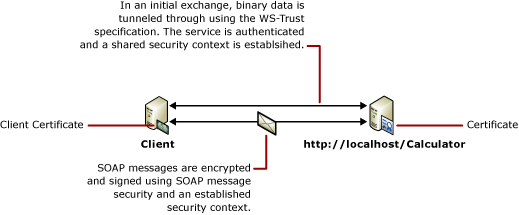Nachrichtensicherheit durch einem Zertifikatclient
Das folgende Szenario zeigt einen WCF-Client (Windows Communication Foundation) und einen -Dienst, die mit dem Nachrichtensicherheitsmodus gesichert sind. Sowohl der Client als auch der Dienst werden mit Zertifikaten authentifiziert. Weitere Informationen finden Sie unter Sicherheit bei verteilten Anwendungen.

Eine Beispielanwendung finden Sie unter Nachrichtensicherheitszertifikat.
| Merkmal | Beschreibung |
|---|---|
| Sicherheitsmodus | `Message` |
| Interoperabilität | Nur WCF |
| Authentifizierung (Server) | Mit Dienstzertifikat |
| Authentifizierung (Client) | Mit Clientzertifikat |
| Integrität | Ja |
| Vertraulichkeit | Ja |
| Transport | HTTP |
| Bindung | WSHttpBinding |
Dienst
Der folgende Code und die folgende Konfiguration werden unabhängig voneinander ausgeführt. Führen Sie eines der folgenden Verfahren aus:
Erstellen Sie einen separaten Dienst, indem Sie den Code ohne Konfiguration verwenden.
Erstellen Sie mit der angegebenen Konfiguration einen Dienst, aber definieren Sie keine Endpunkte.
Code
Der folgende Code zeigt, wie Sie einen Dienstendpunkt erstellen, der zum Herstellen eines sicheren Kontextes die Nachrichtensicherheit verwendet.
// Create the binding.
WSHttpBinding binding = new WSHttpBinding();
binding.Security.Mode = SecurityMode.Message;
binding.Security.Message.ClientCredentialType =
MessageCredentialType.Certificate;
// Create the URI for the endpoint.
Uri httpUri = new Uri("http://localhost/Calculator");
// Create the service host.
ServiceHost myServiceHost =
new ServiceHost(typeof(Calculator), httpUri);
myServiceHost.AddServiceEndpoint(typeof(ICalculator), binding, "");
// Specify a certificate to authenticate the service.
myServiceHost.Credentials.ServiceCertificate.
SetCertificate(StoreLocation.LocalMachine,
StoreName.My,
X509FindType.FindBySubjectName,
"Contoso.com");
// Open the service.
myServiceHost.Open();
Console.WriteLine("Listening...");
Console.ReadLine();
// Close the service.
myServiceHost.Close();
' Create the binding.
Dim binding As New WSHttpBinding()
binding.Security.Mode = SecurityMode.Message
binding.Security.Message.ClientCredentialType = _
MessageCredentialType.Certificate
' Create the URI for the endpoint.
Dim httpUri As New Uri("http://localhost/Calculator")
' Create the service host.
Dim myServiceHost As New ServiceHost(GetType(ServiceModel.Calculator), httpUri)
myServiceHost.AddServiceEndpoint(GetType(ICalculator), binding, "")
' Specify a certificate to authenticate the service.
myServiceHost.Credentials.ServiceCertificate.SetCertificate( _
StoreLocation.LocalMachine, StoreName.My, _
X509FindType.FindBySubjectName, "Contoso.com")
' Open the service.
myServiceHost.Open()
Console.WriteLine("Listening...")
Console.ReadLine()
' Close the service.
myServiceHost.Close()
Konfiguration
Anstelle des Codes kann die folgende Konfiguration verwendet werden:
<?xml version="1.0" encoding="utf-8"?>
<configuration>
<system.serviceModel>
<behaviors>
<serviceBehaviors>
<behavior name="ServiceCredentialsBehavior">
<serviceCredentials>
<serviceCertificate findValue="Contoso.com"
x509FindType="FindBySubjectName" />
</serviceCredentials>
</behavior>
</serviceBehaviors>
</behaviors>
<services>
<service behaviorConfiguration="ServiceCredentialsBehavior"
name="ServiceModel.Calculator">
<endpoint address="http://localhost/Calculator"
binding="wsHttpBinding"
bindingConfiguration="MessageAndCertificateClient"
name="SecuredByClientCertificate"
contract="ServiceModel.ICalculator" />
</service>
</services>
<bindings>
<wsHttpBinding>
<binding name="WSHttpBinding_ICalculator">
<security mode="Message">
<message clientCredentialType="Certificate" />
</security>
</binding>
</wsHttpBinding>
</bindings>
<client />
</system.serviceModel>
</configuration>
Client
Der folgende Code und die folgende Konfiguration werden unabhängig voneinander ausgeführt. Führen Sie eines der folgenden Verfahren aus:
Erstellen Sie mit dem Code (und Clientcode) einen eigenständigen Client.
Erstellen Sie einen Client, der keine Endpunktadressen definiert. Verwenden Sie stattdessen den Clientkonstruktor, der den Konfigurationsnamen als Argument verwendet. Zum Beispiel:
CalculatorClient cc = new CalculatorClient("EndpointConfigurationName");Dim cc As New CalculatorClient("EndpointConfigurationName")
Code
Der folgende Code erstellt den Client. Die Bindung bezieht sich auf den Nachrichtensicherheitsmodus, und der Clientanmeldeinformationstyp wird auf Certificate festgelegt.
// Create the binding.
WSHttpBinding myBinding = new WSHttpBinding();
myBinding.Security.Mode = SecurityMode.Message;
myBinding.Security.Message.ClientCredentialType =
MessageCredentialType.Certificate;
// Create the endpoint address.
EndpointAddress ea = new
EndpointAddress("http://machineName/Calculator");
// Create the client.
CalculatorClient cc =
new CalculatorClient(myBinding, ea);
// Specify a certificate to use for authenticating the client.
cc.ClientCredentials.ClientCertificate.SetCertificate(
StoreLocation.CurrentUser,
StoreName.My,
X509FindType.FindBySubjectName,
"Cohowinery.com");
// Begin using the client.
try
{
cc.Open();
Console.WriteLine(cc.Add(200, 1111));
Console.ReadLine();
// Close the client.
cc.Close();
}
' Create the binding.
Dim myBinding As New WSHttpBinding()
myBinding.Security.Mode = SecurityMode.Message
myBinding.Security.Message.ClientCredentialType = _
MessageCredentialType.Certificate
' Create the endpoint address.
Dim ea As New EndpointAddress("http://machineName/Calculator")
' Create the client.
Dim cc As New CalculatorClient(myBinding, ea)
' Specify a certificate to use for authenticating the client.
cc.ClientCredentials.ClientCertificate.SetCertificate( _
StoreLocation.CurrentUser, StoreName.My, _
X509FindType.FindBySubjectName, "Cohowinery.com")
' Begin using the client.
Try
cc.Open()
Console.WriteLine(cc.Add(100, 11))
Console.ReadLine()
' Close the client.
cc.Close()
Catch tex As TimeoutException
Console.WriteLine(tex.Message)
cc.Abort()
Catch cex As CommunicationException
Console.WriteLine(cex.Message)
cc.Abort()
Finally
Console.WriteLine("Closed the client")
Console.ReadLine()
End Try
Konfiguration
Die folgende Konfiguration gibt das Clientzertifikat mit einem Endpunktverhalten an. Weitere Informationen zu Zertifikaten finden Sie unter Arbeiten mit Zertifikaten. Der Code verwendet auch ein <identity>-Element zur Angabe eines DNS (Domain Name System) der erwarteten Serveridentität. Weitere Informationen zur Identität finden Sie unter Dienstidentität und Authentifizierung.
<?xml version="1.0" encoding="utf-8"?>
<configuration>
<system.serviceModel>
<behaviors>
<endpointBehaviors>
<behavior name="endpointCredentialsBehavior">
<clientCredentials>
<clientCertificate findValue="Cohowinery.com"
storeLocation="LocalMachine"
x509FindType="FindBySubjectName" />
</clientCredentials>
</behavior>
</endpointBehaviors>
</behaviors>
<bindings>
<wsHttpBinding>
<binding name="WSHttpBinding_ICalculator" >
<security mode="Message">
<message clientCredentialType="Certificate" />
</security>
</binding>
</wsHttpBinding>
</bindings>
<client>
<endpoint address="http://machineName/Calculator"
behaviorConfiguration="endpointCredentialsBehavior"
binding="wsHttpBinding"
bindingConfiguration="WSHttpBinding_ICalculator"
contract="ICalculator"
name="WSHttpBinding_ICalculator">
<identity>
<dns value="Contoso.com" />
</identity>
</endpoint>
</client>
</system.serviceModel>
</configuration>